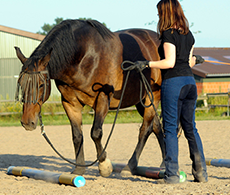
Groundwork exercises to improve your horse’s strength and suppleness
Groundwork, or in-hand work, is a valuable tool for improving your horse’s physical condition, body awareness and manners – all without even getting in the saddle.
Whether you’re bringing a horse back into work, managing a youngster, or simply looking to improve strength and flexibility, well-structured groundwork training for your horse can make a real difference.
By working your horse from the ground, you can assess and correct postural habits, improve coordination, and help them build strength in a more controlled, lower-impact way. Plus, it’s a great way to deepen your partnership and communication.
Best of all, groundwork exercises can be done almost anywhere – a flat area of field or a quiet yard corner – no arena required. Here’s how to get started.
What you’ll need
- Riding hat
- Gloves
- Sturdy boots
- Headcollar and lead rope or lunge line (or a bridle, if you need more control)
Exercise one: Square stance and neck stretch
A good starting point for any groundwork training routine, the square halt helps you identify and address postural imbalances. Horses that find this difficult often have tightness or weakness through the body, and improving this basic posture lays the foundation for better movement under saddle.
How to do it
- Ask your horse to halt, and observe how they naturally stand. Ideally, each hoof should form a corner of a rectangle.
- Adjust each limb carefully until they’re standing square. Use gentle pressure or a voice cue to nudge limbs into place.
- Keep sessions short and repeat regularly. With time, your horse will start offering a square stance more readily.
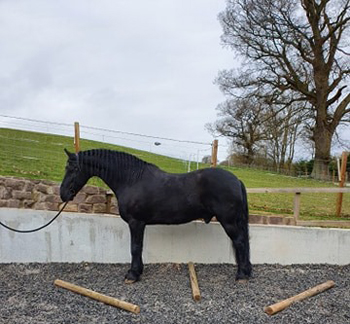
Once your horse is comfortable standing square, introduce a gentle neck stretch:
- Stand by your horse’s shoulder and place a hand behind their poll or upper neck.
- Gently flex their head toward you and hold for a few seconds, up to 30 max if they’re comfortable.
- Repeat on both sides, noting any differences in flexibility.
- To increase the stretch, move your hand incrementally down the neck, stretching each section separately.
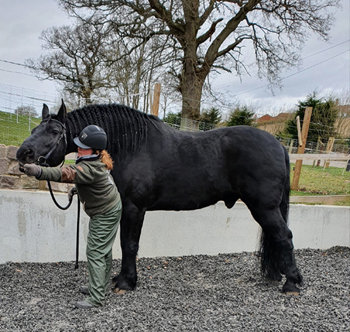
Exercise two: Clockwork poles
Polework isn’t just for riding – this circular in-hand exercise encourages suppleness and rhythm, helping your horse stretch over the topline and step more evenly through the body. It’s one of the most fun groundwork exercises that horses will enjoy while also improving engagement.
How to do it
- Set up eight poles on a circle, like the numbers on a clock face.
- Start with a small circle and lead your horse around, walking over the poles.
- Adjust the diameter depending on their comfort – widen if they stumble or rush, and tighten gradually as suppleness improves.
- Work in both directions for 15-20 minutes, as part of your regular groundwork sessions.
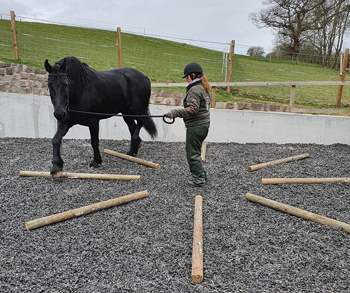
Next steps: Begin to move your horse further out on the circle and then back in again, encouraging bend and engagement of the inside hind leg.
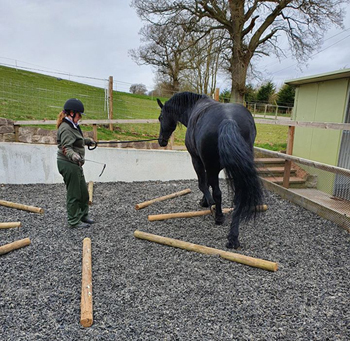
Exercise three: Simple reverse
The ability to step back calmly and evenly engages the hindquarters, improves balance and enhances body awareness, all while strengthening the topline and core.
Among the more basic groundwork exercises for horses, this reverse movement can reveal a lot about your horse’s straightness and posture.
How to do it
- Ask your horse to take a step back by applying light pressure on the lead rope and stepping towards them.
- Look for a relaxed, straight step with a lowered head.
- Reward any effort by releasing pressure and walking forward.
- Over time, build up to three to five straight, calm steps.
- If needed, guide your horse using a pole placed parallel to a wall or fence to keep them straight.
Advance the movement: Once comfortable, ask your horse to back up with a lowered head, using light downward pressure. This engages the entire top line, from poll to tail.
Exercise four: Lateral flexion
Lateral work improves flexibility through the ribs and spine, encourages the horse to step under more deeply with the hindlegs, and helps prevent one-sidedness.
How to do it
- Stand at your horse’s shoulder with a short lead rope.
- Use light pressure to ask for a small step of the forehand away from you; your horse should cross their outside front leg in front of the inside leg.
- Encourage a few steps of this lateral movement, keeping your horse relaxed and forward-thinking.
- Repeat on both sides, aiming for smooth, consistent crossovers.
Top tip: Keep the movement fluid – avoid jerky cues or overcorrecting. The goal is soft, yielding motion that can be built into more complex lateral work later.
Exercise five: Pole zigzags
This dynamic exercise combines lateral work and coordination to boost your horse’s ability to shift weight and bend through their whole body.
It’s another one of those groundwork exercises for horses to build trust as well as physical strength, as it requires them to follow your lead closely.
How to do it
- Lay out three to four poles in a staggered zigzag formation.
- Lead your horse at a walk, weaving between them in an S-shape.
- Use your body position and lead rope pressure to guide each turn, encouraging them to bend slightly around you.
- Repeat several times in both directions, adjusting spacing depending on your horse’s size and agility.
Why it works: As your horse moves through the zigzags, they must shift weight between their shoulders and hindquarters, activating key muscles in the process.
Tips for groundwork training
These basic groundwork exercises for horses, used regularly, will help your horse become more balanced, mobile and engaged – all of which can support long-term soundness and may even lessen the likelihood of a claim on your horse insurance.
When introducing groundwork exercises into your routine, aim for short, frequent sessions. Two to three times per week for 15 to 20 minutes is ideal, especially if your horse is coming back into work or has existing stiffness. Always work both sides evenly, and give your horse time to process new movements.
If your horse feels stiff under the saddle, these exercises can help you find where that tightness is coming from. They’re great tools to have – often, the small improvements you see from the ground translate into better balance and softness when you ride.
Found this article useful? Want to see similar content and engage with like-minded riders? Follow us on Petplan Equine’s Facebook page



